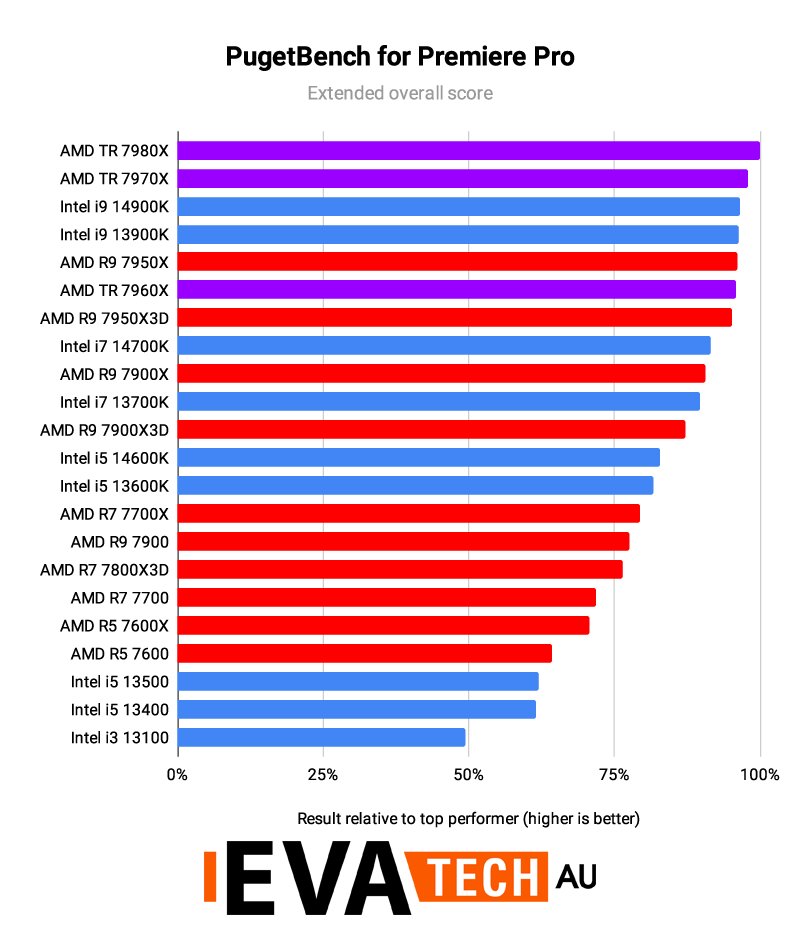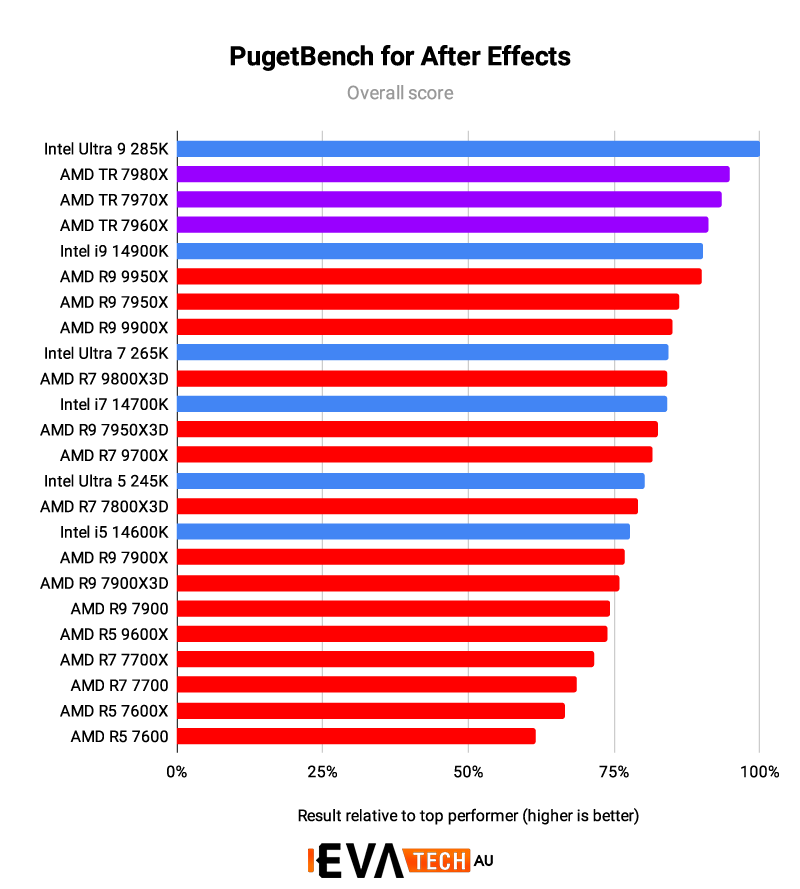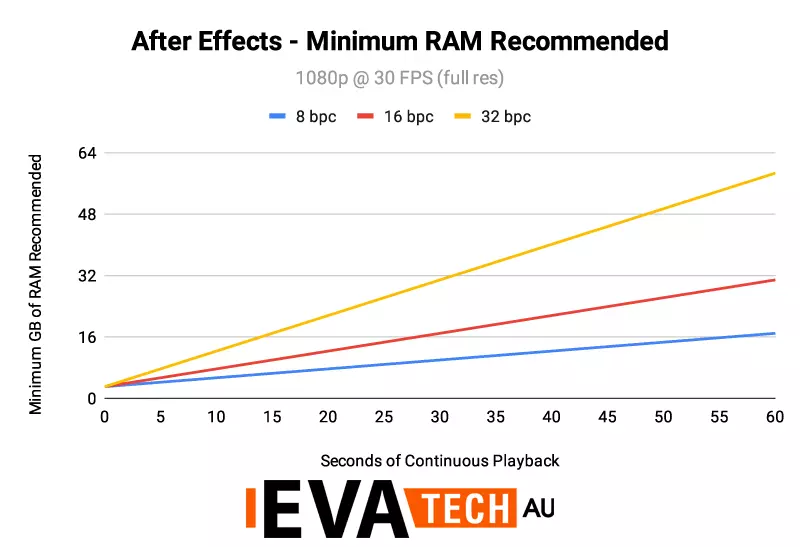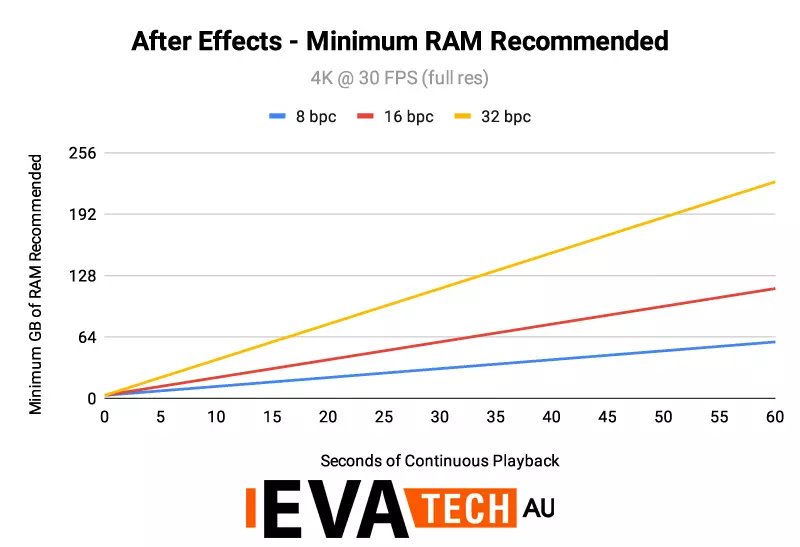Categories
AudioCPU
General
Graphics Card
Maintenance
Monitor
RAM (Memory)
Sustainability
Use Cases
About Evatech
Since 2013, Evatech Computers, a fully Australian-owned and operated company, has provided custom-built gaming, workstation, and home + office PCs, meticulously tailored to individual client needs and budgets.
Shop
Custom Gaming PCs
Custom Workstations
Pre-built PCs
Monitors
Mice
Keyboards
Headsets & Microphones
Configuring a PC for Video Editing
Published 23rd May 2023, updated 23rd Dec 2024 - 12 minute readWhich CPU to pick for video editing?
- CPU - Adobe Premiere Pro
- CPU - Adobe After Effects
- CPU - DaVinci Resolve
How much RAM is enough for video editing?
- RAM - Adobe Premiere Pro
- RAM - Adobe After Effects
- RAM - DaVinci Resolve
What Video/Graphics card (GPU) is optimal for video editing?
- GPU - Adobe Premiere Pro
- GPU - Adobe After Effects
- GPU - DaVinci Resolve
Should I use an Nvidia Quadro / Professional graphics card for video editing?
What storage drive(s) should I use for video editing?
Whether it's for Adobe Premiere Pro, After Effects, DaVinci Resolve, or another video editing application, there is certain hardware that you'll want to consider for your machine. While a powerful and fast video editing PC can be costly, we know that buying something that is not equipped for the task will end up being more frustrating and costly in the long run, so take your time and get it right!
Which CPU to pick for video editing?
Often the most vital part to a good video editing PC is the CPU, and for those on unrestricted budgets the obvious choice is to go with some of the most powerful/expensive CPUs on offer, whether Intel; with sometimes the i7 performing nearly as well as the more costly i9, or AMD; including AMD's Threadripper platform if that has useful features for you. But there are some application specific considerations below to help you get the best value for your money, whether it is with a relatively unrestricted budget, or ensuring you only spend what is necessary.
CPU - Adobe Premiere Pro
If your work is primarily H.264 and H.265 (HEVC) you will find that Intel's Ultra 9 285K or the outgoing Intel i9 14900K (thanks to the built-in QuickSync functionality) are the best performers.
If working with RED footage, AMD's Threadripper Pro range performs favourably, with the high-end consumer grade options performing nearly half as well.
More CPU cores/threads will improve performance in exporting but not so much for live playback. Premiere Pro does not scale well with higher core counts, so Threadripper should not be high on your list, also since they are massively more costly than consumer grade platforms.
Intel or AMD?
AMD is ahead in terms of live playback & export performance in most instances. Though, Intel's CPUs, particularly in the most recent 14th generation chips, are solid options as they perform similarly to similarly-priced AMD CPUs but also include QuickSync to process H.264 and HEVC media rather than leaning on the GPU for those tasks which frees the GPU to process GPU-accelerated effects, etc.
CPU - Adobe After Effects
The graph below tells the story of the top-performing consumer-grade CPUs performing relatively similar with the exception of the new Intel Ultra 9 285K which widens the gap. Single-threaded workloads will see these CPUs slash through loads faster than the more costly AMD Threadripper CPUs, but Threadripper races ahead in After Effects' new Multi-Frame Rendering mode. Additionally, Threadripper systems allow for up to 2,048GB of RAM - or 512GB via our website - (consumer grade tops out at 192GB) which can be advantageous for projects with higher resolution or longer timelines as it can cache more frames.
Before After Effects' multi-frame rendering (MFR), more CPU cores did not scale well with it mostly utilising a single core which made high clock speeds more important than core count. With MFR introducing the ability for multiple frames to be rendered at once (providing the system has enough resources: available cores, RAM, GPU time/VRAM) high clock speeds are still important, but the number of cores and other supporting hardware has become a larger consideration. If you are using Cinema 4D renderer, or third-party product such as BG Renderer, these too can make better use of additional CPU cores.
CPU - DaVinci Resolve
Davinci Resolve certainly relies heavily on the performance of the GPU (especially when using OpenFX or noise reduction), but the CPU is still critical as it is part of everything your system does, so you will not want that to cause a bottleneck after spending appropriately elsewhere!
For single GPU systems, a high clock speed CPU with a fair core count is a good pick, which is practically anything mid-range (U5/i5/R5 or U7/i7/R7 if you have the budget) or above from Intel's 200 Series/14th gen or AMD's Ryzen 7000/9000 series.
If you are packing two or three GPUs, or work with RAW video codecs, you will see a performance boost from a CPU with a higher core count, often meaning AMD's Threadripper platform.
How much RAM is enough for video editing?
The exact amount of RAM varies depending on how you use your system (if multitasking lots of resource-intensive applications rather than just running one to focus on at a time for example) to the length, codecs, complexity, and resolution that you are manipulating. But again, there are some software specific considerations that we can offer as a guide, and then you can make the right choice accordingly.
RAM - Adobe Premiere Pro
| Footage Resolution | 1080p (1920x1080) | 4K (3840x2160) | 6K (6144x3160) | 8K (8192x4320) |
12K (12288x6480) |
| Minimum RAM recommendation | 64GB | 96GB | 128GB | 192GB | 256GB |
RAM - Adobe After Effects
After Effects can often benefit from having large amounts of RAM available which lets After Effects store more previews in RAM rather than on a cache disk which will result in smoother playback. Using a high-speed SSD as a cache drive is good, but no storage solution can match the speeds of RAM, so this is your first line of defence in ensuring speed.
The ideal amount of RAM you want for After Effects depends on the resolution of your projects, the colour bit depth (bpc), and the number of frames you want to be able play continuously. So, in order to determine how much RAM you ideally want, you can use the following formula:
[desired seconds of playback] x [FPS] x [pixel height] x [pixel width] x [number of bits per channel] / 2,147,483,648 + 3
Or, you can simply reference the charts below to immediately understand what the above formula means.
The RAM requirement scales linearly with framerate, so if you want to pull off 60 FPS you need to double the RAM indicated above.
In instances where you might not have a particular need, 64GB of RAM is recommended, with 128GB the go-to if you might be working with higher resolutions (4K+) on occasion.
RAM - DaVinci Resolve
Davinci Resolve's RAM requirements are a little lighter than the previous two examples - but of course depends on length, complexity, and resolution of your projects - keeping in mind that you might be multi-tasking though.
As a healthy guideline:
| Footage Resolution | 1080p (1920x1080) | 4K (3840x2160) | 6K (6144x3160) | 8K (8192x4320) |
12K (12288x6480) |
| Minimum RAM recommendation | 64GB | 96GB | 128GB | 192GB | 256GB |
What Video/Graphics card (GPU) is optimal for video editing?
While Adobe software solutions have been making steps to better utilise dedicated GPUs over the recent years, a high-end GPU isn't necessary unless you heavily use GPU-accelerated effects in your Premiere Pro / After Effects projects, otherwise the performance difference between a high-end GPU and a mid-range one is fairly small as far as video editing is concerned, but will save you a lot of money.
DaVinci Resolve, on the other hand, utilises the GPU(s) present quite heavily. Being mindful of the fact that the free edition is limited to using just a single GPU, the studio edition can use up to eight, though we do not actively advocate for more than two GPUs per system in most cases.
GPU performance is made up of both their processing power (often measured by processing cores, such as CUDA cores and/or ray-tracing cores, etc.) and VRAM which is dedicated RAM for the GPU which is to say it is independent of your system RAM discussed above.
GPU - Adobe Premiere Pro
Starting with Premiere Pro v14.2, support has been added for GPU-based hardware acceleration for exporting H.264/H.265 which can cut export times by up to 5x. Furthermore, as of v14.5; H.264/HEVC decoding can now leverage the GPU which can provide a substantially smoother editing experience when using these codecs.
The more GPU-accelerated effects you use and the faster you want to be able to export to H.264/HEVC, the larger the benefit of using a high-end GPU becomes. It is costly, but a good option is the RTX 4080 with the RTX 4090 of course being the fastest.
| Sequence Resolution | 1080p (1920x1080) | 4K (3840x2160) | 6K (6144x3160) | 8K+ (8192x4320) |
| Minimum VRAM recommendation | 4GB | 8GB | 12GB | 16GB+ |
GPU - Adobe After Effects
Like Premiere Pro, the RTX 4080 is a solid pick, with the RTX 4090 being the best overall (by a little bit).
Having enough VRAM for your projects is also important, with multi-frame rendering being able to process more than one frame at a time you will want to have more VRAM, otherwise the number of frames will be limited. This plays into why the RTX 4080 with 16GB of VRAM is recommended, while the RTX 4090's 24GB of VRAM being beneficial to others.
GPU - DaVinci Resolve
Benefiting greatly from a dedicated GPU with the RTX 4090 being the best card you can get for DaVinci Resolve (performing roughly on par with dual GPUs from the previous generation). RTX 4080 provides superb performance once again. While the Studio Edition of DaVinci resolve can use multiple GPUs, additional cards do not get to see 100% of their potential (instead it is only up to 50%) so the cost outlay begins to not make as much sense as a single, more powerful GPU option would. Important to note that multiple GPUs does not stack the VRAM capacity.
| Timeline Resolution | 1080p (1920x1080) | 4K (3840x2160) | 6K / 8K+ (6144x3160 / 8192x4320) |
| Minimum VRAM recommendation | 8GB | 12GB | 20GB+ |
Should I use an Nvidia Quadro / Professional graphics card for video editing?
While Adobe's Premiere Pro & After Effects + DaVinci Resolve work fine with professional GPU options, the consumer-grade GeForce cards are the better choice as they're significantly more affordable and usually beat the performance of the pro-grade cards. The only tangible benefit of a pro card is they will offer greater amounts of VRAM at price points, but that only goes so far towards the actual performance.
What storage drive(s) should I use for video editing?
With the CPU, RAM, & GPU often taking so much of the focus when it comes to configuring a PC for video editing, the storage configuration can get left out, or is an afterthought when most of the budget is already spent... this can be a huge and costly mistake! If the storage is not able to keep up with the CPU, RAM, & GPU - it will create a bottleneck and then it will not matter how fast or capable other hardware is.
There are a few main types of storage options on offer today, and they all have their pros and cons, so it makes sense to know & understand them, and often use a combination of storage drives in the video editing PC.
- SATA HDDs: Traditional spinning hard disk drives, the one that most people are likely familiar with already. While these the slowest storage option we offer, they are extremely affordable compared to the SSD counterparts, and also come in much larger capacities than SSDs can. They make for very good long-term storage solutions, for archival purposes, etc. but in most instances are not ideal to work off directly. Speeds max out at around 150MB/s.
- SATA SSDs: Operating on the same protocol as the above HDDs (SATA) these Solid-State Drives contain no moving parts and are multiple times faster than HDDs, but are more costly for the benefit. These max out around the 540MB/s range.
- NVMe M.2 SSDs: These currently come in two flavours on our website. As it stands we have Gen4 drives, and Gen5 drives. Gen4 NVMe M.2 SSDs generally top out at around 7,000MB/s while the Gen5 NVMe M.2 SSD drives start in the 9,xxxMB/s range and go up to 14,000MB/s.
These M.2 drives also connect directly to the motherboard (which may limit the amount of M.2 drives you can have in total as some may only support 2-3) which frees up the case/chassis drive bays for future additions that you may want.
Don't forget, it's important that you are in control of your data backups at all times!
For professional video editing we promote a three-drive configuration with the capacity and type of each depending on your desired budget and performance level.
- OS & Applications (SATA SSD or NVMe M.2 SSD) - Should be large enough to house your operating system plus any other applications you require as part of your workflow. An SSD of either type will allow the OS and programs start up fast, which makes the overall operation of the system feel snappy.
- Project files (SATA SSD or NVMe M.2 SSD) - Having your projects on their own drive ensures that in case your primary drive has an issue that requires an OS reinstall you won't need to worry about also losing the projects you need to work on. Using either an SSD of either type for your project files, with the decision coming down to your budget and what bitrate your source media is.
- Media cache & scratch (NVMe M.2 SSD) - A dedicated drive for your media cache and scratch files will improve performance when playing and scrubbing through compositions. It also isolates high-stress cache and scratch files away from other data, so that if they cause the drive to fail prematurely all you lose is temporary data that your applications can easily regenerate if needed. In a budget pinch, a SATA SSD will also do.
- Optional (SATA SSD or HDD) - If data hoarding is your thing, it will likely be necessary to have additional drives. These can go towards organisation of your work, backup, archiving, etc. so at your discretion, and according to budget constraints, you can safely pick either an SSD or HDD.
External drives are a cause for concern as they are known to contribute to performance and stability issues. External drives should therefore only be used to move data to the PC - then work on it - and move it back onto an external drive if needed, but you should not be working directly from an external drive.
Something still not right with your Evatech PC? We're standing by and our support team can assist you!
Contact Evatech SupportIf this page didn't solve your problem, there's many more to view, and they're all very informative.
Evatech Help Docs













 5/2 Fiveways Boulevarde, 3173 VIC
5/2 Fiveways Boulevarde, 3173 VIC Monday - Friday 10am-6pm
Monday - Friday 10am-6pm +61 (03) 9020 7017
+61 (03) 9020 7017 ABN 83162049596
ABN 83162049596 Evatech Pty Ltd
Evatech Pty Ltd